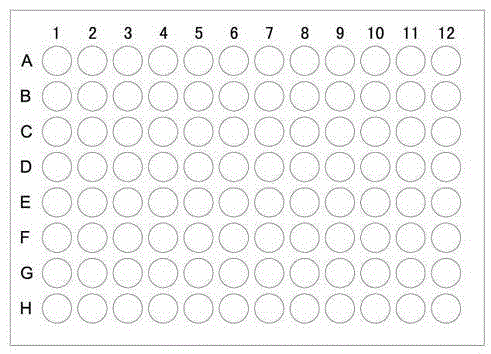Method for amplifying antibody marking signal or nucleic acid probe marking signal
A signal amplification and antibody labeling technology, applied in the field of immunoassay, can solve the problem of low sensitivity and achieve the effect of high sensitivity, no radioactive pollution and good stability
- Summary
- Abstract
- Description
- Claims
- Application Information
AI Technical Summary
Problems solved by technology
Method used
Image
Examples
Embodiment 1
[0031] Determination of carcinoembryonic antigen in human serum (taking 10 blood samples from the physical examination center of a hospital)
[0032] Preparation of LPS solution: Weigh 0.01g of LPS and dissolve in 1 mL of 0.1mol / L NaCO 3 Dissolve in the solution, then add 1 mL of newly prepared 0.1mol / L NaIO4 solution, after reacting in a water bath at 55°C for 120 minutes, add 40 μl of isopropanol, place in a refrigerator at 4°C for 30 minutes, centrifuge at 12,000 rpm / min for 10 minutes, discard the supernatant and wash the precipitate twice with 1 mL of pure water, each time 5 seconds, then with 1 mL of 0.1mol / L NaCO 3 solution to prepare LPS solution.
[0033] Preparation of antibody solution: take 0.01 g of rabbit anti-mouse antibody to be labeled, and use 0.5 mL of 0.1 mol / L NaCO 3 The solution was dissolved to prepare an antibody solution.
[0034] Preparation of LPS-antibody cross-linked product: LPS solution and antibody solution were mixed at a volume ratio o...
Embodiment 2
[0043] Determination of carcinoembryonic antigen in human serum (taking 10 blood samples from the physical examination center of a hospital)
[0044] Preparation of (1,3)-β-D-glucan (abbreviated as; dextran in this example) solution: Weigh 0.01g of dextran and dissolve in 1 mL of 0.1mol / L NaCO 3 Dissolve in the solution, then add 1 mL of newly prepared 0.1mol / L NaIO 4 After reacting in a water bath at 55°C for 60 minutes, add 40 μl of isopropanol, place in a refrigerator at 4°C for 30 minutes, then centrifuge at 12,000 rcf for 10 minutes, discard the supernatant and wash the precipitate twice with 1 mL of pure water, each time 5 seconds, then use 1 mL of 0.1mol / L NaCO 3 solution to prepare a dextran solution.
[0045] Preparation of antibody solution: take 0.01 g of rabbit anti-mouse anti-antibody to be labeled, and use 0.5 mL of 0.1mol / L NaCO 3 Dissolve in the solution to prepare antibody solution.
[0046] Preparation of dextran-antibody cross-linked product: Mix dextr...
Embodiment 3
[0054] Detection of fetal DNA in maternal peripheral blood (take blood samples from healthy pregnant women in a hospital, a total of 3 people):
[0055] The microplate is a product of Nunc Company in Denmark, and the probe is synthesized by ABI Company in the United States. The probe sequence is: 5′A TTC TT C GGC AGC ATC TCT GC 3′ (3′ hydroxylation).
[0056] Preparation of LPS solution: Weigh 0.01g of LPS and dissolve in 1 mL of 0.1mol / L NaCO 3 Dissolve in the solution, then add 1 mL of newly prepared 0.1mol / L NaIO 4 After reacting in a water bath at 55°C for 60 minutes, add 40 microliters of isopropanol, place in a refrigerator at 4°C for 30 minutes, and then centrifuge at 12,000 rpm / min for 10 minutes. Discard the supernatant and wash the precipitate twice with 1 mL of pure water. Each time for 5 seconds, and then dissolved in 1 mL of 0.1mol / L NaCO3 solution to prepare LPS solution.
[0057] Preparation of probe solution: Take a tube (1 OD) of probe DNA to be labeled, a...
PUM
 Login to View More
Login to View More Abstract
Description
Claims
Application Information
 Login to View More
Login to View More - R&D
- Intellectual Property
- Life Sciences
- Materials
- Tech Scout
- Unparalleled Data Quality
- Higher Quality Content
- 60% Fewer Hallucinations
Browse by: Latest US Patents, China's latest patents, Technical Efficacy Thesaurus, Application Domain, Technology Topic, Popular Technical Reports.
© 2025 PatSnap. All rights reserved.Legal|Privacy policy|Modern Slavery Act Transparency Statement|Sitemap|About US| Contact US: help@patsnap.com

